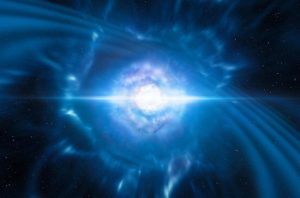The story of Betelgeuse has kicked things off, so it seems appropriate to discuss Supernova.
I am sure if I asked the question;
“What is a Supernova“
Most would answer the obvious,
“An old star exploding at the end of it’s life“
Whilst true, it is also not accurate either.
There was a time when a Supernova was just a Supernova, but then researchers realised that there were different types of Supernova, initially they were Type I and Type II. However, is soon became apparent that things were not as simple as that, so lets take a look at the different types of Supernova, what causes a star to become one, and what type of star becomes what type of Supernova.
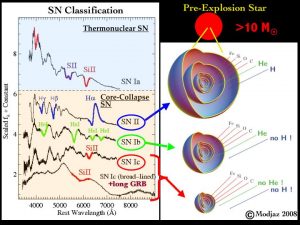
©Dr Maryam Modjaz
Type Ia Supernova
Researchers found that when they looked at certain types of Supernova explosion there was a lack of Hydrogen visible in the spectra of the exploded star. Whilst the spectra shows very little hydrogen it does show a lot of carbon; they also show silicon, calcium, and elements up to iron (the result fusion during the intense explosion). It was soon realised that this was a new type of Supernova, one caused not by the collapse of the core of a Supergiant star, but rather by the collapse of a White-Dwarf star, the remnant of a star no too dissimilar to the Sun.
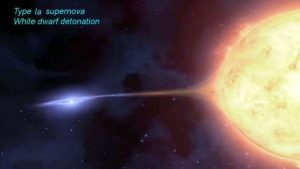
A White Dwarf cannot simply collapse all by itself, it needs to exceed 1.4 solar masses (2.765×10E30 kg), the Chandrasekhar Limit for White Dwarf Stability. All observed Type Ia supernova fall into two categories;
A binary Star system where a giant or Supergiant has expanded as it ages and fills it’s Roche Lobe, material then falls on the white dwarf star, forming an accretion disk at first, which may actually cause a repeating Nova in the first instance, but when enough material coalesces on the White dwarf and it’s mass exceeds the Chandrasekhar limit, collapse of the White dwarf is guaranteed.
When the White Dwarf, which is composed mostly of Carbon, collapses under the force of gravity, the temperature rises dramatically, this results in the fusion of carbon into new elements, however, this carbon detonation is catastrophic for the White Dwarf, the result is a massive explosion that we call a Type Ia Supernova.
Type Ia Supernova can also be the result of the collision of two White Dwarf Stars.
Type Ib Supernova
This type of Supernova is also noted for the lack of Hydrogen in the spectra, but unlike Type Ia above, they show helium. It is believed that this type of Supernova results from the collapse of stars more than 25 times the mass of the Sun.
As the stars evolve along the asymptotic giant branch of the H-R diagram they shed their outer layers, these are the stars we now believe evolve into Red Hypergiants, back into Yellow and Blue Supergiants and later explode in a Type Ib supernova explosion, as happened to Sanduleak-69+202 in 1987, resulting in the Supernova SN1987A.
As the star sheds mass it’s gravitational force reduces, thus allowing it to continue burning fuel at it’s core, however, as with Type II supernova, once the core of the star has an Iron mass more than 1.4 times the mass of the Sun it explodes as a Supernova.
Type Ic Supernova
As with the Type 1b, these show little to no Hydrogen or helium in their spectra, but other aspects of them are different from standard Type Ib, these are little understood at the moment, but researchers believe that they are, like Type Ib, stripped cores of truly massive stars, stars that have frantically shed tens of solar masses to continue fusion, shed their outer layers in repeated expansions, exposing the next layer, which then expands and repeats the process, this continues again until the core reaches a critical mass of Iron, cannot produce any more energy, gravity collapses it, and we see a Type Ic Supernova.
Type II Supernova
Current thinking on Type II supernova is that they are the result of the core collapse of stars between 8 and 25 times the mass of the Sun. These supernova show considerable Hydrogen and Helium in their spectra and it is believed that these stars are at the right mass range to continue the fusion process, without shedding too much of their original mass whilst on the asymptotic giant branch of the H-R diagram. When they core reaches that critical Iron mass, we see a Type II Supernova.

What causes the Core to Collapse?
As giant stars age they use up the fuel in their core, just as all stars do, but the larger the star, the faster it uses up it’s fuel. When a Star gets to a certain point, hydrogen fusion in the core slows, this reduces the “gas pressure” in the core that is balancing the force of the enormous gravitational field of the star. When this happens the core begins to slowly contract, this reduces the hold on the outer layers of the star and they cool as they expand, this is how stars turn from dwarf stars, like the Sun, to Red Giants. Depending on the mass of the star, this process will continue all the way through the elements in the bottom of the periodic table until the core is full of Iron. The star will now resemble and onion, with successive layers fusing heavier elements into even heavier elements.

Core Collapse Process.
©Oak Ridge National Laboratory
However, there is a problem with Iron, Iron requires more energy to fuse into heavier elements than the reaction releases. This results in the core slowly contracting until the mass of Iron reaches the Chandrasekhar limit of 1.4 Solar Masses. At this point the core is crushed by the gravity of the star in milliseconds, as the core collapses all the materials making it is crushed even smaller, then it reaches a point called Neutron degeneracy, where all the protons and electrons have been squeezed together to form Neutrons, the core has become a Neutron Star, but as this happens, the outer layers collapse inwards too, the core momentarily rebounds as it reaches the Neutron limit,. emitting huge quantities of Neutrinos in the process.
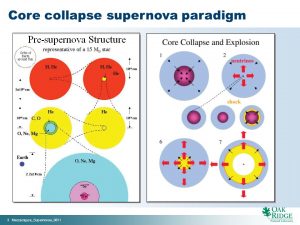
Core collapse supernova paradigm.
©Oak Ridge National Laboratory
When the Neutrinos and the rebounding core meet the collapsing outer layers, they heat, create a massive shock wave, and the result is a Supernova Explosion.
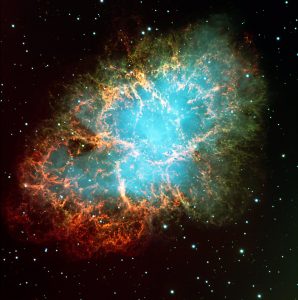
This photo shows a three colour composite of the well-known Crab Nebula (also known as Messier 1), as observed with the FORS2 instrument in imaging mode in the morning of November 10, 1999. It is the remnant of a supernova explosion at a distance of about 6,000 light-years, observed almost 1,000 years ago, in the year 1054. It contains a neutron star near its centre that spins 30 times per second around its axis (see below). In this picture, the green light is predominantly produced by hydrogen emission from material ejected by the star that exploded. The blue light is predominantly emitted by very high-energy (“relativistic”) electrons that spiral in a large-scale magnetic field (so-called synchrotron emission). It is believed that these electrons are continuously accelerated and ejected by the rapidly spinning neutron star at the centre of the nebula and which is the remnant core of the exploded star. This pulsar has been identified with the lower/right of the two close stars near the geometric centre of the nebula, immediately left of the small arc-like feature, best seen in ESO Press Photo eso9948. Technical information: ESO Press Photo eso9948 is based on a composite of three images taken through three different optical filters: B (429 nm; FWHM 88 nm; 5 min; here rendered as blue), R (657 nm; FWHM 150 nm; 1 min; green) and S II (673 nm; FWHM 6 nm; 5 min; red) during periods of 0.65 arcsec (R, S II) and 0.80 (B) seeing, respectively. The field shown measures 6.8 x 6.8 arcminutes and the images were recorded in frames of 2048 x 2048 pixels, each measuring 0.2 arcseconds. North is up; East is left.
©European Southern Observatory
Kilonova
Only one such event has been positively confirmed, others likely missed or miss identified. This is the name coined for gargantuan explosions caused when two Neutron Stars collide. The first such event was observed in 2016 by multiple observatories and by
LIGO, the gravitational wave detector.
Further Reading
Modjaz, M. et al., (2009), “From Shock Breakout to Peak and Beyond: Extensive Panchromatic Observations of the Type Ib Supernova 2008D associated with Swift X-ray Transient 080109”, ApJ, 702, 226 [as pdf ]
Modjaz, Kirshner, Blondin, Challis, & Matheson (2008a), “Double-peaked Oxygen Lines Are not Rare in Nebular Spectra of Core-Collapse Supernovae”, ApJL, 687, L9 [as pdf ]
Tominaga, N. et al. (2005), “The Unique Type Ib Supernova 2005bf: A WN Star Explosion Model for Peculiar Light Curves and Spectra”, ApJ, 633,L97
Modjaz, M. et al., “Optical and NIR Light Curves and Spectra of 30 Type Ib, IIb and Ic Supernovae”, in preparation







